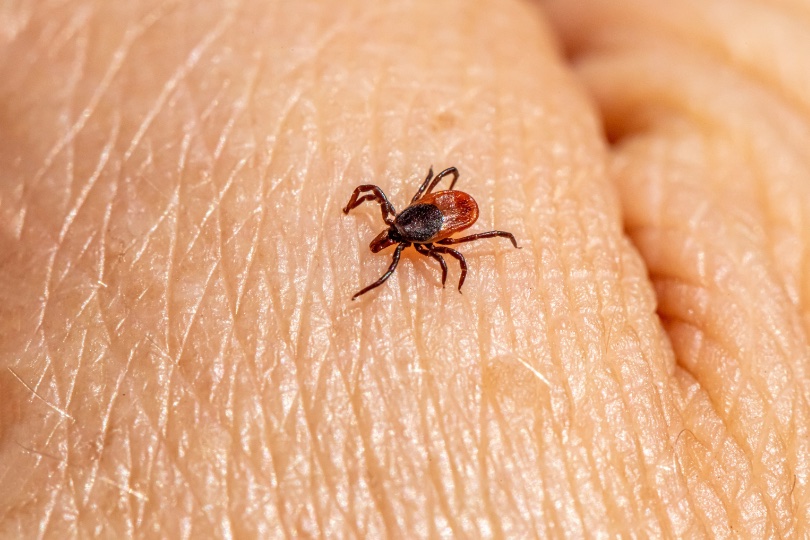Heading outdoors? You may want to throw on some long pants and a hat—even if it’s hot.
Ticks are out in record numbers this year. The Centers for Disease Control and Prevention reports that emergency room visits for tick bites are at their highest level since 2017. Locally, Inova-GoHealth Urgent Care centers saw more than twice as many tick-related illnesses from May 1-Aug 8 compared with the same time period last year.
Not all ticks carry bacteria that can sicken humans, but the mid-Atlantic region has seen an increase in cases of Lyme disease, the most prevalent tick-borne illness. Lyme is transmitted when the bacteria from a tick bite enter the bloodstream.
“In Virginia, we’ve already had…about 300 Lyme disease cases reported for the year, which is higher than we normally see,” says Meredith Porter, medical director for the Inova-GoHealth centers.
The first reported case of Lyme disease in the U.S. dates to 1977 in Old Lyme, Connecticut, hence the name. In the worst cases, Lyme can cause long-term neurological problems. However, it is easily treatable with common antibiotics, and lifelong illness is rare.
What’s Causing the Increase?
Heat and humidity are a factor. Stretches of 100-plus-degree days led to the hottest summer on record to date, according to Capital Weather Gang, which monitors DMV weather. We’ve also had one of the most humid summers on record. Ticks thrive in temperatures warmer than 45 degrees and with 85% humidity.
Development of wooded lands is another cause, says Luis Dominguez, an internal medicine physician at VHC Health. “While ticks can crawl around, they’re normally hitching a ride on furry woodland creatures like deer,” he says. “As our suburbs and our developments expand into previously deer-only habitats, now the deer are walking through our backyards or they’re just closer in proximity to us, and so you can end up getting exposure to ticks that way.”

How to Spot a Tick
Blacklegged (aka deer) ticks are the only ticks that carry the bacteria that causes Lyme, according to the Virginia Department of Health. They pose the biggest threat in late spring and summer, when more people are outside and the insects are in their nymph stage. “Blacklegged tick nymphs are tiny (about the size of a poppy seed), and their bites cause very little or no itch or irritation,” according to the state agency. “Most people never realize they have been bitten unless the tick attaches to a part of the body in plain sight.”
Symptoms To Know
Lyme symptoms can take anywhere from three to 30 days to appear after an initial tick bite as the bacteria works its way through the body.
One telltale sign is a target-shaped rash resembling a bullseye at the site of the bite, but that appears in only 60% to 70% of cases, says Inova’s Porter. Other symptoms, including fever, headache and body aches, may develop within about seven to 10 days after a bite.
Additional symptoms that can arise anywhere from 3 to 10 weeks later include extensive rashes, neurological issues (such as tingling), irregular heartbeat and arthritis, especially in the knee. If those occur, go to the emergency room, Porter says.
Symptoms are largely the same for people all ages, but children are more likely to have fevers and facial nerve palsy. Kids are also more likely to present with knee swelling from arthritis. Adults are more likely to feel nerve pain in their extremities, she says.
If you feel ill and test negative for the flu or Covid, or if you saw a tick on your body, visit a doctor for a blood test that can detect Lyme.
If the Lyme test comes back negative, ask to be tested for ehrlichiosis and babesiosis—two other tick-borne diseases that are rare but present in our area, Dominguez says. Ehrlichiosis is an umbrella terms for diseases caused by three types of tick-borne bacteria, while babesiosis is a disease caused by a parasite spread through deer tick bites.
How to Treat Tick-borne Illnesses
An antibiotic called doxycycline treats all three infections. “We’re probably talking a couple weeks of treatment, but the good news is they are treatable,” Dominguez says.
Rarely, patients may experience long-term effects, such as systemic rashes and neurological symptoms like Bell’s palsy, which causes paralysis on one side of the face. Arthritis has also been linked to Lyme. Only 5% to 20% of patients develop chronic symptoms after contracting Lyme, according to Columbia University’s Lyme and Tick-Borne Diseases Research Center.
Although some people experience lingering symptoms, Dominguez says there is still a debate in the medical community about whether Lyme is a chronic condition. “There could be something residual left over, which is a chronic complication of Lyme, similar to long Covid,” he says. “So, could there be long Lyme? The jury’s out.”
If symptoms do persist beyond the course of antibiotics, it’s time to speak with a specialist, Dominguez adds.
What to Do If You Find a Tick
The sooner you remove a tick the better, to limit the transmission of bacteria. Getting them off within 24 hours is ideal, Porter says.
“In urgent care…we’ll see people coming in [because] they found a tick, and either they can’t get it off themselves or they’re worried about getting it off or they want us to get it off,” she says.
To remove a tick yourself, use tweezers to grab it as close to the skin as possible. Then, squeeze gently and use upward pressure to pull it off.
“Slowly remove it, because it’s going to have its little pincers in you,” Dominguez says. Avoid twisting it because “you might snap the tick off and then a little piece of the tick is going to be left in your skin.”
If that happens, don’t dig at the bite, Porter adds, as doing so can injure the skin. “Just clean it really well with some rubbing alcohol,” she says. “Your body’s going to expel those little mouth parts. As long as the tick is now not alive, it’s not going to be able to pass on Lyme disease or an infection that is a tick-borne illness.”
How to Prevent Tick Bites
Doctors recommend taking these steps to prevent tick bites:
- Wear long pants and long-sleeve shirts.
- Tuck your pants into your socks.
- Shower after being outside.
- Throw your clothes in the dryer to kill anything that might be on them.
- Ask someone to do a tick check of your body—”and that includes all the less fun cracks and crevices,” Dominguez says.
- Treat your pets with tick prevention so the insects don’t attach to them, fall off and move on to you.
- Use Environmental Protection Agency-approved insect repellent such as permethrin or a formulation that contains DEET.
“You have to embrace the chemicals on this one because the ticks don’t care about herbal remedies,” Dominguez cautions.
If you find a tick that hasn’t attached to a person or pet, assume that it still could have bitten you. At that point, you have two options, he says: Wait to see if symptoms develop or visit an urgent care for a one-time dose of doxycycline. Taken prophylactically, the antibiotic can prevent bacteria from multiplying in your bloodstream.
And finally? Don’t let let this news put a damper on what’s left of summer. Ticks can be present all year, anyway. “We want people to be outside,” Porter says. “It’s good to protect yourself year-round.”
